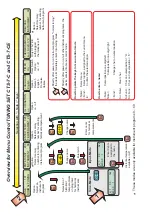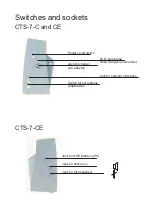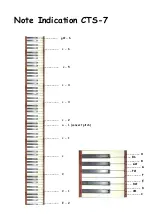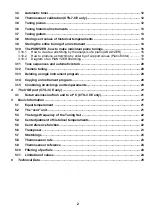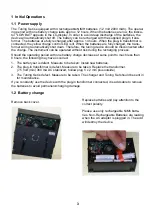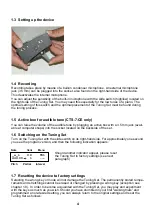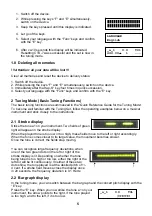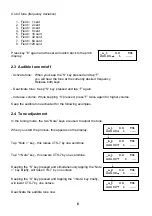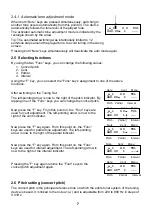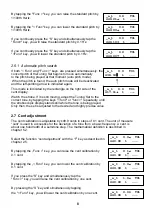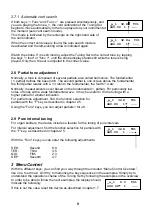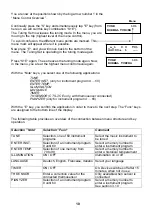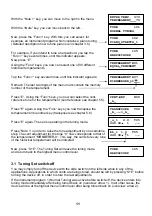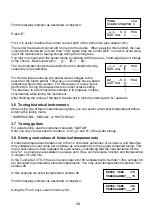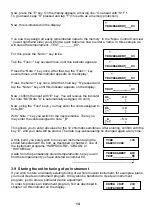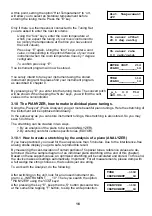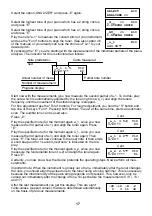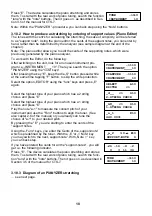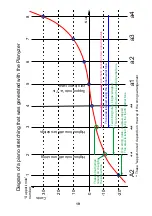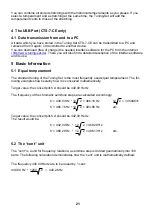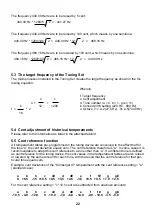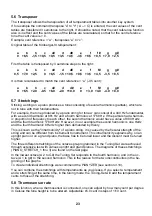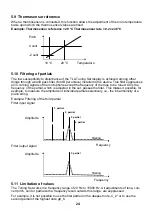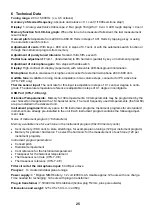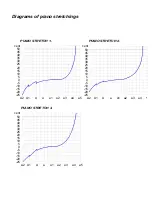
12
3.2 Illumination on/off
Find this indicator on the display as described in chapter 0:
Now, using the “Func“ keys, you can turn the illumination on or off.
3.3 Automatic timer
Find this indicator on the display as descibed in chapter 0:
The timer function can be turned on or off with the “Func“ keys.
A timer was installed in the Tuning Set, to save battery power.
If you don't use the set for fifteen minutes, it automatically turns
itself off.
Before shut-down, it will set off short accoustic signals for about 30 seconds. This allows you to
prevent shut-down by pressing any of the seven keys. If the Tuning Set automatically shuts down,
you can restart it with the on/off switch on the right side by switching it off and then on again.
3.4 Thermosensor calibration (CTS-7-CE only)
This menu serves to calibrate the thermosensor input for a thermosensor available as accessory
for the CTS-7-CE. The menu point is available only when a sensor is actually connected to the
device.
The thermosensor controls the target frequency of the set in
relation to the measured room temperature.
See chapters 3.9., 5.4 and 5.9.
For calibration, find this display indicator as described in chapter 0:
On the right side you see the room temperature measured by the sensor.
On the left there is an offset value that is added to the indicated temperature.
The offset can now be adjusted until the indicated temperature corresponds to the actual room
temperature. When leaving this function, the calibration offset value is stored.
3.5 Tuning pianos
First things first: One cannot overemphasize the fact that piano tuning requires experience. If it is
done without the necessary knowledge and skills, the piano may be irreparably damaged. In one
tuning, a piano should never be raised or lowered by more than 30 cent.
When tuning instruments with thick strings such as pianos and grand pianos, “stretching” the tun-
ing becomes necessary. This implies that, different from the standard tuning mode, the high tones
must be tuned higher and the low tones lower. We will discuss this further in chapter 5.7 of this
Manual.
The permanently stored instrument programs “PIANO_STRETCH_1 to 3” are considering this by
using inharmonicity curves. That is, a cent value is given for each tone, which shows the offset of
the piano tuning from the equally tempered tuning.
For these tone-stretching tasks, each of the 60 instrument programs possesses a memory space
for each tone capable of registering a deviation of up to ±99,9 cent per tone.
The selection of the optimal stretching depends on various parameters of the instrument to be
tuned. Individual preferences of the musician also play a vital role. Three permanently-stored in-
strument programs are available in the CTS-7. You may store the temperaments of up to 51 pi-
anos in the CTS-7. Using the „PIANYZER“ you can create special stretchings suitable to individu-
al instruments (see section 3.10).
The three built-in stretchings found in the system are the result of trials, during which various pi-
anos were tuned by ear, and subsequently measured. You must try out the stretching most suited
to match your particular requirements first. For your first attempts, we recommend that you try the
Piano Stretch 3. For this please apply the following:
ILLUMINATION 400
on
TIMER 600
on
THERMOSENSOR
corr. 1.0 18.4°C
Содержание TUNING SET CTS-7-C
Страница 1: ...Manual TUNING SET CTS 7 C TUNING SET CTS 7 CE engeneering office for modern electronic design E V 1 52...
Страница 2: ......
Страница 36: ...www tuning set de...

